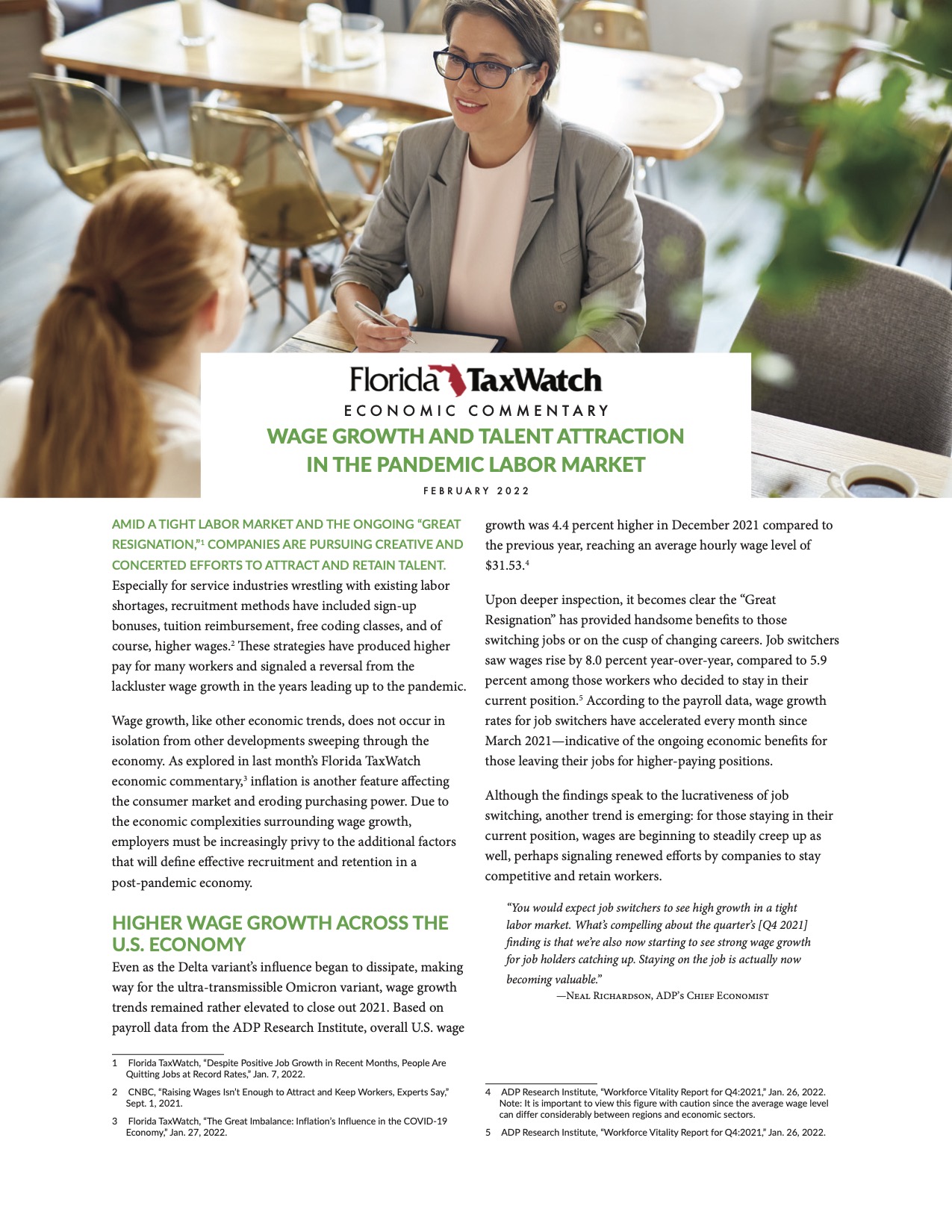Wage Growth and Talent Attraction in the Pandemic Labor Market

Amid a tight labor market and the ongoing “great resignation,” companies are pursuing creative and concerted efforts to attract and retain talent. Especially for service industries wrestling with existing labor shortages, recruitment methods have included sign-up bonuses, tuition reimbursement, free coding classes, and of course, higher wages. These strategies have produced higher pay for many workers and signaled a reversal from the lackluster wage growth in the years leading up to the pandemic.
Wage growth, like other economic trends, does not occur in isolation from other developments sweeping through the economy. As explored in last month’s Florida TaxWatch economic commentary, inflation is another feature affecting the consumer market and eroding purchasing power. Due to the economic complexities surrounding wage growth, employers must be increasingly privy to the additional factors that will define effective recruitment and retention in a post-pandemic economy.
The “Great Resignation” has provided handsome benefits to those switching jobs or on the cusp of changing careers. Job switchers saw wages rise by 8.0 percent year-over-year, compared to 5.9 percent among those workers who decided to stay in their current position. Although the findings speak to the lucrativeness of job switching, another trend is emerging: for those staying in their current position, wages are beginning to steadily creep up as well, perhaps signaling renewed efforts by companies to stay competitive and retain workers.
However, these registered wage gains are occurring against the backdrop of decades-high inflation. When exploring weekly earnings data—provided by the U.S. Labor Department—average weekly earnings grew by 4.7 percent in December 2021 compared to December 2020 (See Figure 1). After accounting for inflation, so-called “real” wages declined by 2.3 percent compared to the previous year. In other words, higher consumer prices have eaten into paycheck gains for many workers. Exactly how much inflation erodes pay gains for workers depends on various factors, such as the consumer’s job, income level, and purchasing behavior. These nuances underscore the need to consider wage gains in the context of the cost of living among different areas in Florida.
Much like the rest of the nation, Florida has recorded significant wage growth over the preceding year due to the labor market’s competitive landscape. The Accommodation and Food Services sector saw wages grow by 28.4 percent since the lockdown of 2020—swiftly outpacing every other sector (See Figure 2). At the other end of the spectrum, Florida’s Education Services; Utilities; and Arts, Entertainment, and Recreation sectors experienced the slowest wage growth of all sectors in Florida between the second quarter of 2020 and 2021. In nominal terms (without considering inflation), these sectors only saw paychecks rise between 1.4 and 2.5 percent.
When comparing these sector-level figures to national findings,11 Florida TaxWatch finds that wage gains in Accommodation and Food Services have grown faster than the national average of 18.4 percent, perhaps reflective of Florida’s service-intensive economy. Even for more remote work sectors, such as Finance and Insurance and Professional and Technical Services, year-over-year wage growth outperformed the national averages of 9.8 and 7.9 percent, respectively.
What do these changes signal for the future of hiring and talent retention for Florida’s businesses and workers? Cash compensation may very well be “king” in this current tight labor market; however, more than just base pay, factors such as work flexibility, childcare support, and professional development will begin to play a larger role in decision-making for current and prospective employees.
Wage growth can be expected to maintain its upward momentum as long as the tight labor market persists in 2022. If trends continue, Florida’s wage growth may outpace national averages in both service industries and more telework-intensive industries. Although wages and compensation are top of mind for Florida, beyond 2022, the recruiting and retention landscape for many businesses must adjust to the shifting preferences of employees seeking more flexibility and opportunity for upward mobility.
Documents to download
-
Feb-22-EC(.pdf, 642.85 KB) - 1084 download(s)